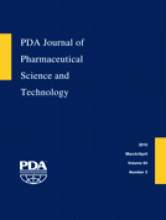Abstract
This article describes a method for achieving the load equivalence model, described in Parenteral Drug Association Technical Report 1, using a mass-based approach. The item and load bracketing approach allows for mixed equipment load size variation for operational flexibility along with decreased time to introduce new items to the operation. The article discusses the utilization of approximately 67 items/components (Table IV) identified for routine sterilization with varying quantities required weekly. The items were assessed for worst-case identification using four temperature-related criteria. The criteria were used to provide a data-based identification of worst-case items, and/or item equivalence, to carry forward into cycle validation using a variable load pattern. The mass approach to maximum load determination was used to bracket routine production use and allows for variable loading patterns. The result of the item mapping and load bracketing data is “a proven acceptable range” of sterilizing conditions including loading configuration and location. The application of these approaches, while initially more time/test-intensive than alternate approaches, provides a method of cycle validation with long-term benefit of ease of ongoing qualification, minimizing time and requirements for new equipment qualification for similar loads/use, and for rapid and rigorous assessment of new items for sterilization.
- Steam sterilization
- Variable load
- Mixed load
- Autoclave
- Validation
- Risk-based approach
- Load equivalence
- Load bracketing
- Item bracketing
- © PDA, Inc. 2010
PDA members receive access to all articles published in the current year and previous volume year. Institutional subscribers received access to all content. Log in below to receive access to this article if you are either of these.
If you are neither or you are a PDA member trying to access an article outside of your membership license, then you must purchase access to this article (below). If you do not have a username or password for JPST, you will be required to create an account prior to purchasing.
Full issue PDFs are for PDA members only.
Note to pda.org users
The PDA and PDA bookstore websites (www.pda.org and www.pda.org/bookstore) are separate websites from the PDA JPST website. When you first join PDA, your initial UserID and Password are sent to HighWirePress to create your PDA JPST account. Subsequent UserrID and Password changes required at the PDA websites will not pass on to PDA JPST and vice versa. If you forget your PDA JPST UserID and/or Password, you can request help to retrieve UserID and reset Password below.






